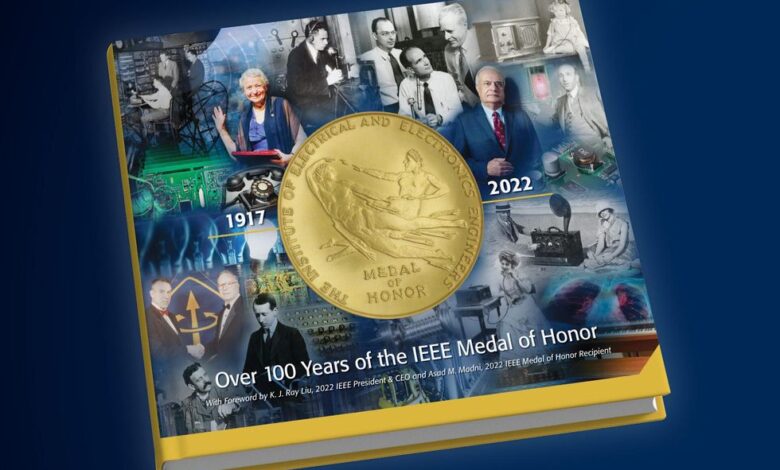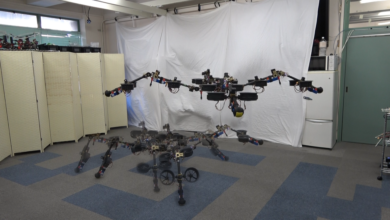IEEE’s Medal of Honor Ebook Explores 100 Years of Innovation

For more than a century, IEEE has been honoring technology pioneers with its Medal of Honor. The organization’s most prestigious award, it is given to engineers who have made exceptional contributions to or had an extraordinary career in electronics, electrical sciences, and engineering.
To celebrate the award’s long history, IEEE recently released a commemorative ebook, Over 100 Years of the IEEE Medal of Honor. The volume chronicles the innovators who have received the award since its establishment in 1917. The Medal of Honor has been awarded annually since its establishment except in 1925, 1947, 1965, and 1976.
“The Medal of Honor is a living testament to the lives and careers of these major contributors in our modern world,” K.J. Ray Liu, the 2022 IEEE president, wrote in the book’s forward. “The recipients featured in this book are remarkable individuals who have made enormous contributions to science, technology, the engineering profession, and IEEE.”
An award for radio engineers
Although professional medals of recognition and accomplishment for engineers and academic scientists were well established by the 1900s, there was no award specifically for electrical specialists working in communications.
That changed in February 1917, when the Institute of Radio Engineers (IRE), a predecessor society of IEEE and the leading technical and scientific society in the communications field, established the Medal of Honor. The award was designed to recognize prominent advances made in radiotelegraphy and radiotelephony.
“The Medal of Honor is a living testament to the lives and careers of these major contributors in our modern world.”
Nominees for the award had to have made public their “greatest patented or unpatented advance in radio communication” within the previous two years, according to an entry about the honor on the Engineering and Technology History Wiki. The innovation or technological advancement had to have been “publicly and completely described in a scientific or engineering journal of recognized standing.” And the technology was required to be fully operational. Two years later the IRE eliminated the two-year time frame and the publication requirement.
After the IRE merged in 1963 with the American Institute of Electrical Engineers, IEEE’s other predecessor society, the combined organization broadened the Medal of Honor to include biomedicine, computing, transistors, and other technologies.
Honoring Robert N. Noyce, Nick Holonyak Jr., and others
Here is a quick look at some of the recipients profiled in the book.
Edwin H. Armstrong, the first recipient, was regarded as one of the top contributors to the field of radio electronics. In 1918 he invented the superheterodyne circuit, a selective means of receiving, converting, and amplifying weak, high-frequency electromagnetic waves, now used in virtually all broadcast radio receivers as well as televisions. His most well-known achievement, in 1933, was inventing wide-band frequency modulation, now known as FM radio. He received the award in 1917 for his work and publications dealing with the action of oscillating and non-oscillating audio.Robert Noyce, inventor of the first practical integrated circuit, received the 1978 Medal of Honor for “contributions to the silicon integrated circuit, a cornerstone of modern electronics.” Noyce also helped found Fairchild Semiconductor and Intel, both of which helped spawn Silicon Valley. In 1999 IEEE established a medal in his name.Paul C. Lauterbur is the person to thank for MRIs. He received the 1987 medal for discovering “nuclear magnetic resonance imaging.” His work later was honored with a 2003 Nobel Prize in Medicine.Nick Holonyak Jr. invented the first practical visible-spectrum LED while working as a consulting scientist in 1962 at General Electric’s Advanced Semiconductor Laboratory. The technology is now used in lightbulbs and lasers. IEEE honored him in 2003 for “a career of pioneering contributions to semiconductors, including the growth of semiconductor alloys and heterojunctions, and to visible light-emitting diodes and injection lasers.” In November 2022, the IEEE Nick Holonyak Jr. Medal for Semiconductor Optoelectronic Technologies was established. The award is slated to be presented for the first time in 2024 at the annual IEEE Honors Ceremony.Mildred Dresselhaus, called the “queen of carbon science,” pioneered the study of carbon nanostructures at a time when studying physical and material properties of commonplace atoms was out of favor. Her work in unraveling the electronic structure of carbon paved the way for the discovery of fullerenes, carbon nanotubes and graphene. Dresselhaus is the only female Medal of Honor recipient. She was honored in 2015 for “leadership and contributions across many fields of science and engineering.” In 2020 IEEE established an award in her honor.Chenming Hu, known as the “father of the 3D transistor,” invented the FinFET in 1999. Intel, the first company to implement FinFETs in its products, called the invention the most radical shift in semiconductor technology in more than 50 years. Hu received the award in 2020 for “a distinguished career of developing and putting into practice semiconductor models, particularly 3D device structures, that have helped keep Moore’s Law going over many decades.”Jacob Ziv received the 2021 Medal of Honor for “fundamental contributions to information theory and data compression technology, and for distinguished research leadership.” Ziv codeveloped two lossless data compression algorithms: Lempel-Ziv 77 in 1977 and LZ78 the following year. Enabling perfect reconstruction from compressed data, and more efficient than previous algorithms, they allowed for the development of GIF, PNG, and ZIP files.Asad Madni led the development of the GyroChip, which revolutionized navigation and stability in aerospace and automotive systems, making them safer. He was honored with the 2022 Medal of Honor for “pioneering contributions to the development and commercialization of innovative sensing and systems technologies, and for distinguished research leadership.”
IEEE Spectrum




